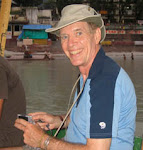 as dawn is breaking, the drive becomes steeper. We eat lunch, or perhaps a late breakfast, in Barkot. It is now noon, and we are at approximately 4,000 feet. It is too early for us to appreciate the comfort of this altitude, or the fact that the paved roads on which we have been driving much of our trip will give way shortly to eight days of unpaved roads, washouts, landslides, and trails. In this moment we enjoy the children heading to school, the blue sky, and the clouds that still wrap the mountains.
as dawn is breaking, the drive becomes steeper. We eat lunch, or perhaps a late breakfast, in Barkot. It is now noon, and we are at approximately 4,000 feet. It is too early for us to appreciate the comfort of this altitude, or the fact that the paved roads on which we have been driving much of our trip will give way shortly to eight days of unpaved roads, washouts, landslides, and trails. In this moment we enjoy the children heading to school, the blue sky, and the clouds that still wrap the mountains.We get to Jankichatti an hour and a half later than we had expected to arrive. For those of us new to India, we have yet to learn that is not a delay, nor anything to be concerned with. It is the flow of life.
Our first trek is to Yamunotri and back. I pack my knapsack as I intend to pack it for the longer treks; for me, this is a “test flight.” I pick up my poles. I don’t complete the trek, turning around and returning to the guest house after an hour and a half on the trail. Lesson 1: I do not need to (and physically will not be able to) carry my 35mm digital (for color) and my 35mm film (for black and white). Lesson 2: I am okay with the altitude. Lesson 3: It is not a race. Lesson 4: Enjoy the scenery. On the way up my focus was the destination; on the return I see the monkeys, the green birds, the clouds wending their way through the valleys and along the trails. I consider the trek a success; I have learned important things about how to succeed going forward.
September 2 (16:13): We are at camp, at Seema. In Jankichatti we stayed in a guest house. It was my introduction to a bathroom where the toilet is a porcelain basin in the floor (Lesson 5: When using, only bring your pants to your knees). For a shower we order a bucket of hot water, and scoop it over ourselves. Tonight in camp the toilet is a hole in the ground (inside a latrine tent), and there will be no shower for another two days.
Overnight the rain was incessant. Halfway from Jankichatti to our starting point in Hanuman Chatti, the road had been washed out. We left the cars, starting the trek kilometers early. As it turns out, there had also been landslides that blocked portions of the road. All in the life of a pilgrim….

It was quite the trek. I was carrying my 35mm digital. It kept on swinging and bouncing. When I anchored it with my belt, I found myself being pulled forward by its weight. I could not lengthen the strap enough to be comfortable. Tomorrow it will go in my pack. It is too much; I will use my point and shoot and be content.
Today I often found myself thanking Mitchel for the challenge, and the variety, of my training. Those thanks will be amplified in the days to come. I also expressed thanks for quick dry clothing (even though, in the clouds and the rain they remain wet as I write this). And, thank you to the discovery of trekking poles. I am the only one with them; and I find them a tremendous help.

Today was a struggle. I learned a few more lessons. Lesson 5: There is always one more ankle-deep stretch of mud to traverse than there is clear glacial spring to ford. Lesson 6: The mud is never pure. Lesson 7: The best place to set down your next footstep has been marked for you in the recent past by a cow, a donkey, or a water buffalo.
Tomorrow, my mantra will be, Make it effortless.



